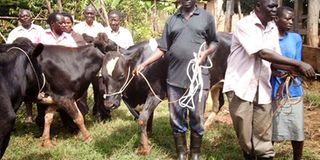How to pick breed for semen extraction

Dairy farmers tend to their dairy cows. Artificial Insemination (AI) is one of the most important techniques ever devised for the genetic improvement of farm animals. FILE
What you need to know:
- It is no longer uncommon to spot agricultural extension officers out in the fields carrying out AI on local or indigenous animals.
- It is important to note that high-yielding animals can be reared but will require intensive management that comes with huge financial requirements to ensure the desired outputs are realised.
Some drivers of the livestock sector such as globalisation, population and income growth are bound to change the dynamics in the livestock sector.
The rise in demand for animal products will boost productivity as well as competitiveness.
But how can smallholder farmers contribute to growing livestock markets? Can this be made possible by utilising technologies such as artificial insemination to improve and increase production?
Artificial insemination (AI) is a commonly used practice in animal breeding. This reproductive technology has slowly taken root in many developing countries and governments as well as private companies, which are preserving semen collected from a varied range of beef and dairy cattle breeds.
It is no longer uncommon to spot agricultural extension officers out in the fields carrying out AI on local or indigenous animals.
A percentage of smallholder farmers have embraced this technique. The desire to improve their production is evident. Artificial insemination offers a relatively ‘quicker’ option for farmers who would like to improve their herd but do not have a good performing bull.
It also gives the farmer a chance to choose her preferred breed. AI is advantageous as the semen is collected from selected bulls with high genetic potential.
With the latest improvements in sexing technologies, ‘female’ and ‘male’ semen can be isolated and provided to farmers thereby influencing the sex percentage in their herd.
Unfortunately, this is still a relatively new technique and a considerably expensive service to source.
More often than not, however, farmers are inadequately equipped with the knowledge to choose from which breed’s semen to serve their cows.
Important factors to consider include:
Matching genotype to phenotype: One should ensure that the desired crossbreed can survive or easily adapts to the prevailing environment and is productive.
It is important to note that high-yielding animals can be reared but will require intensive management that comes with huge financial requirements to ensure the desired outputs are realised.
However, in situations where a smallholder farmer is keen on undertaking AI services, then one must consider the prevailing environment as well as the production systems in place before selecting the desired bull’s genetic material.
Dystocia: This is a condition commonly associated with difficulties in calving. The common cause of dystocia is a small-framed cow trying to give birth to a large calf. For example, the common Small East African Zebu, which is typically small-framed inseminated with Holstein Friesian or the improved Kenyan Boran semen would be recipe for disaster.
However, the Boran x Angus cross would pose no difficulties in calving for a Boran cow.
AI is a reproductive technology that should be encouraged and supported as its huge benefits are evident in some developed countries such as France and Brazil, which have embraced the technique nationally.
These countries are presently placed among the top 10 milk producers. Increased advocacy on the increased and guided utilisation of this technique should be undertaken more extensively.
Dr Muchunguh is a livestock expert




